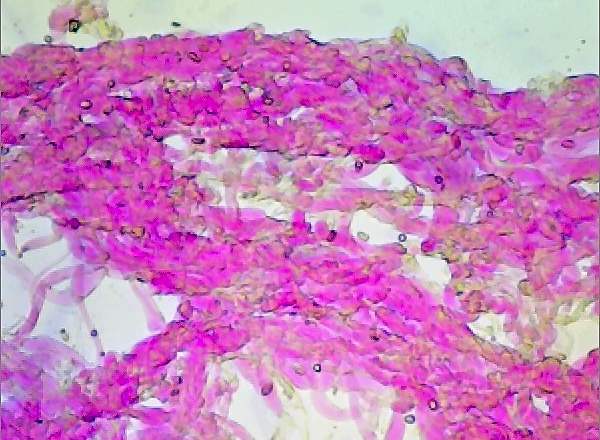Hygrocybe russocoriacea (Berk. & T.K. Mill.) P.D. Orton & Watling - Cedarwood Waxcap
Phylum: Basidiomycota - Class: Agaricomycetes - Order: Agaricales - Family: Hygrophoraceae
Distribution - Taxonomic History - Etymology - Identification - Culinary Notes - Reference Sources
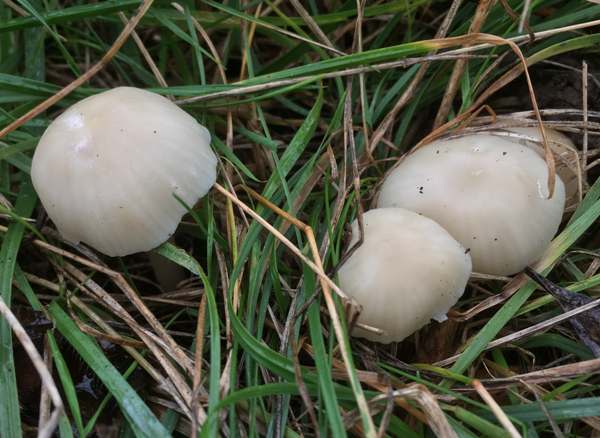
Its distinctive odour is the most obvious differeence between this whitish waxcap and the otherwise macroscopically very similar Snowy Waxcap Cuphophyllus virgineus.
Distribution
Fairly common throughout most of Britain and Ireland, Hygrocybe russocoriacea is also recorder in many parts of mainland Europe from Scandinavia down to the Mediterranean. This species is also listed on some North American websites as occurring in parts of the USA.
Taxonomic history
Described scientifically in 1848 by British mycologists Miles Joseph Berkeley and T. K. Miller, who named it Hygrophorus russo-coriaceus, the Cedarwood Waxcap was transferred to the genus Hygrocybe in 1969 by two other British mycologists, Peter Orton and Roy Watling (b. 1938), whereupon it acquired its currently accepted scientific name Hygrocybe russocoriacea.
Synonyms of Hygrocybe russocoriacea include Hygrophorus russocoriacea Berk. & T.K. Mill., Camarophyllus russocoriaceus (Berk. & T.K. Mill.) J.E. Lange, and Cuphophyllus russocoriaceus (Berk. & T.K. Mill.) Bon.
Etymology
The genus Hygrocybe is so named because fungi in this group are always very moist. Hygrocybe means 'watery head'. russocoriacea comes comes russo- meaning Russian and -coriaceus, the Latin word for leather; it stems from the smell of Russian leather associated with this waxcap.
Identification guide
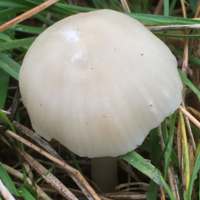 |
CapSlightly sticky; 0.5 to 3cm across; initially convex, becoming flat-topped and sometimes developing a slight depression; cream or ivory to pale yellowish, slightly darker in the cent; margin slightly translucently striate. |
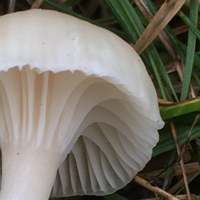 |
GillsModerately didtant; deeply decurrent; initially almost white, becoming slightly yellowish with age. Stem1.5 to 4cm long and 3 to 65mm diameter; cylindrical, tapering at the base; dry and silky; concolorous with cap, often with a pinkish tinge towards the base; hollow; no stem ring. |
SporesEllipsoidal to ovoid; 7.5-9 x 5.5-6.5µm; inamyloid. Spore printWhite. BasidiaClavate, 40-55 x 6-7.5µm, mainly four-spored.
|
|
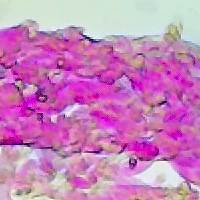 |
Gill TramaInterwoven - see photomicrograph, left. |
Odour/taste |
Odour of 'Russian leather' or sandalwood; taste not distinctive. |
Habitat & Ecological role |
Closely cropped or mown grassland, including coastal dune systems, where artificial fertilisers and herbicides are not spread. Waxcaps have long been considered to be saprobic on the dead roots of grasses and oter grassland plants, but it is now considered likely that there is some kind of mutual relationship between waxcaps and mosses. |
Season |
Autumn and early winter in Britain and Ireland. |
Similar species |
Cuphophyllus virgineus is similar but does not have the cedarwood or Russian leather odour. |
Culinary Notes
Although reported in some field guides to be edible, these tiny waxcaps are so insubstantial that they are of no culinary interest
Reference Sources
Fascinated by Fungi, 2nd Edition, Pat O'Reilly 2016, reprinted by Coch-y-bonddu Books in 2022.
Fungi of Northern Europe, Volume 1 - The Genus Hygrocybe, David Boertmann, 2010.
Dictionary of the Fungi; Paul M. Kirk, Paul F. Cannon, David W. Minter and J. A. Stalpers; CABI, 2008
Taxonomic history and synonym information on these pages is drawn from many sources but in particular from the British Mycological Society's GB Checklist of Fungi.
Acknowledgements
This page includes pictures kindly contributed by Simon Harding.
Fascinated by Fungi. Back by popular demand, Pat O'Reilly's best-selling 450-page hardback book is available now. The latest second edition was republished with a sparkling new cover design in September 2022 by Coch-y-Bonddu Books. Full details and copies are available from the publisher's online bookshop...
